South Island Part IV: Milford Sound Stories and Visuals
The bus from Queenstown to Milford Sound via Te Anau left from the i-site at a brutal hour in the morning. Luckily my sleep schedule had adapted itself to the Intercity bus schedule and so I wasn’t too terribly groggy. While I was being loaded onto the bus, I became aware of a large number of round, ancient looking people wearing khaki with large Olympus cameras dangling against their chests, drawling out “y’alls” and “how you doin’s.” It had been a long time since I had seen so many Americans of this demographic, or should I say any Americans of this demographic.
Halfway into the ride, we had a lunch/toilet break at Te Anau. The bus pulled up alongside Kiwi Country, a tourist trap if I ever did see one. Somehow I managed to get myself trapped in this wonder-world of overpriced souvenirs. To my disbelief I found myself buying things, a tie with kiwis on it and chocolates with kiwifruit filling, and thinking, I wish my grandparents were among this crowd; they’d buy me lunch. But then I remembered, they probably would not have been up for bungy jumping, so it all evened out in the end.
As we pulled away from Kiwi Country, the man who sat in front of me with a shiny head and a belly that could have been in its second trimester turned around. “So, do you live in New Zealand?”
“No, just for the past few months. Why?”
“Oh, you must be Aussie, then.”
I was shocked. What a huge compliment! First the bus driver to Queenstown had thought I was English; now this American thought I was Kiwi, and when I wasn’t Kiwi, I was “Aussie, then.” …And people wonder why I feel I never quite fit in.
I’m from your country, mate! “I’m American,” was my flat, disbelieving response.
“Oh I didn’t catch your accent. I’m from Virginia.”
I can tell. “So am I.”
“Oh really?”
Yes, really.
The closer we got to Milford Sound, the wetter it became, the colder, thicker, and stronger the rains fell. Then again, I wasn’t exactly surprised, or dissappointed. With an annual rainfall of 800cm, yes you read that right, Milford Sound is one of the wettest places on earth, not counting the oceans. Keep that in mind if you’re planning to walk the 53.5km Milford Track. The reason this area gets so much rainfall, as does much of the whole west coast of New Zealand for that matter, is Australia. Warm air from continental Australia heads out over the Tasman Sea, picking up moisture as it goes. This warm wet air is stopped by the innumerable mountains in the Fiordland region, cooled, and caused to dump all of its Tasman moisture on the windward, in this case westward, side of the mountains, where Milford Sound just happens to be.
I had it on one authority that Milford Sound required a rainy day in order to be fully appreciated. I had it on another that it is necessary to see Milford Sound in at least two kinds of weather… rain and shine. Sure enough both authorities were right. As I arrived on the only passable road into Milford Sound, which is only passable given that no avalanches have found their way across it, I discovered the true beauty of the wet Milford.
Not yet in the sound… between Te Anau and Milford

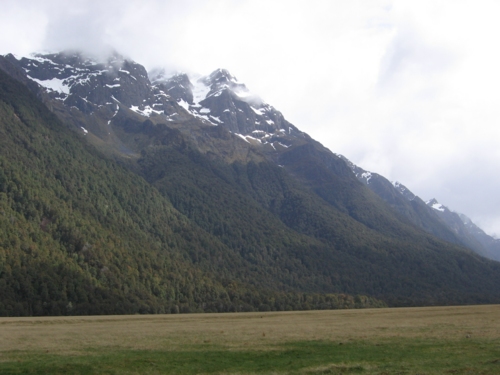
It is critical to your appreciation of the region to drive into, or out of, Milford Sound on a rainy day for the following reason: Waterfalls. Oh, and do I mean Waterfalls with a big, fat, capital W. Never in my life have I seen so many, and never will I again. They ran in hundreds as veins down the glacier-smoothed peaks. Yet again, New Zealand was reminding me just how unimpressive I was compared to the grandness of Mother Earth. I stared in awe as the life-blood of Milford ran down into its network of streams and rivers. I stared out the window, wide-eyed right alongside the Americans who didn’t know I was American.
The truly wonderfal fall was the one that simply fell away to nothing. Caught by wind in its downward rush, it evaporated into the air, never reaching the ground below.
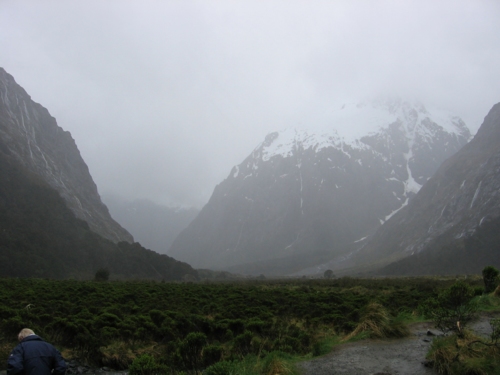
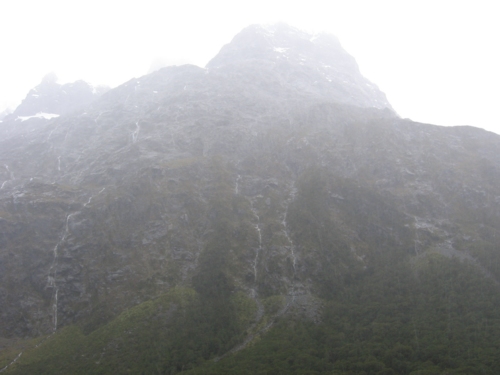
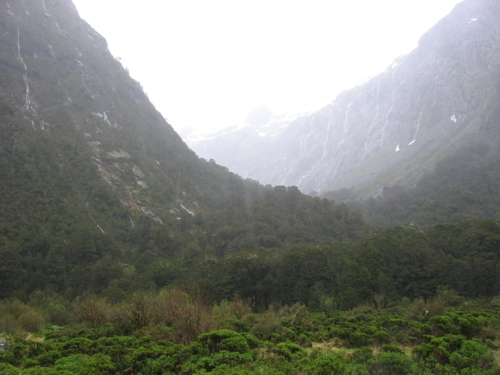

These amazing waterfalls only exist when it rains. They don’t run from rivers or any sort of reservoir as most waterfalls do. They are the product of millions of tiny droplets falling from the sky at a rate fast enough to create hundreds of waterfalls with their force alone.
The water that runs from these mountaintops also carries with it minerals pulverized by the falls and deposited like a turquoise die in the rivers below. These minerals and the purity of the fresh rainwater make for safe, nutrient-rich, refreshing, naturally-refrigerated drinking water.
As everything in Milford seems to revolve around water, so does the trip in. Most buses entering Milford Sound will be sure to stop at The Chasm, only special water-wonder. The Chasm is something that must be seen to be fully appreciated. It is a place, along the path of one of the rivers, where years of heavy rains have washed out the rocks, making what is effectively a chasm, fancy that. On a rainy day, the chasm is filled with rushing, humbling water, swirling, defying gravity, slowly carving faces in the rocks. On a sunny day, the water-level drops, water pools in the carved hollows, and the product of so much time and force is revealed. For the imaginative traveler, these rocks are sculptures, resembling the art and icons of our culture, Romeo, Juliet, and The Scream, to name a few.
The bus dropped me off with two other travelers in a puddle at the end of a driveway. The American tourists stared fascinated as the bus driver helped me lug my Gregory backpack onto my back, and my smaller L.L. Bean bag onto my chest for balance’s sake. I made my way through the rain up to the entrance of Milford Sound Lodge, the only backpackers in Milford Sound, and the only lodging in Milford Sound, period. The building was simply built, and un-insulated as most New Zealand buildings are, but it was a site for cold, wet eyes. Unfortunately the bed I was to be sleeping in had not yet been cleaned, so I had a few hours to kill before I would be able to change out of my soaking wet jeans and Victoria University sweatshirt. I left my bags in the locked baggage closet, and headed out down the road for a real hike in real rain, with the Lodge manager’s warning to turn back if the weather worsened.
About a kilometer away, I came to a trailhead I had noticed on the way in. I skipped from rock to fern root to rock over the little rivers and lakes forming along the worn parts of the trail. Undercover of dense forest canopy, I remained about as dry as a person can be when tramping in a near-Antarctic rainforest. I was doing a fair job of keeping my feet dry if nothing else, but I quickly realised that at this rate my five hour hike would soon become a ten hour swim. I headed back to the Lodge.
The road.
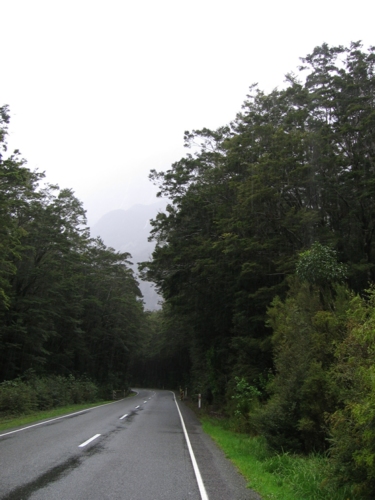
The trail
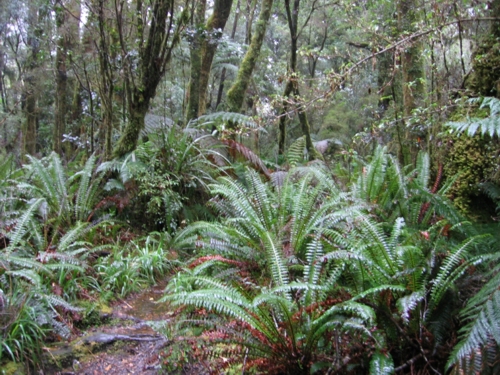
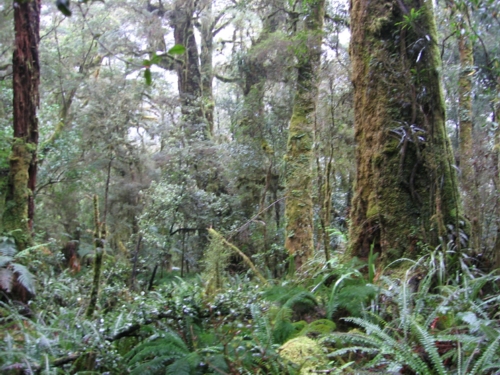
I was happy to find that the staff was kind enough to give me the key to my room so I could change my clothes, and hang up the wet ones. In the communal kitchen, I brewed a cup of tea to warm my bones. I asked after a book exchange, and sure enough there was a box lying on the floor in a corner, containing several dozen books. I chose my best option, a novel called The Crew, and quietly curled up on a couch with a view out the window. I was determined to finish the 300 pager before I left.
That night, I unrolled my sleeping bag on my sheet-less, but nonetheless comfortable mattress and awaited the moment when the generator would be turned off. Eleven o’clock rolled around and the generator sighed its mechanical sigh as it went to sleep for the night.
In the morning I woke early, too early really, to prepare myself for my half-day kayak experience on the Sound with Rosco’s Kayaks for NZ$95. It was a beautiful day, barely a cloud in sight. They picked us up at the Lodge, giving us a basic rundown on procedure and safety. We rode in a van with wet, sea-salt sticky seats to the Sound and came around to park beside what appeared to be a small green hangar. We changed into our stylin’ grub, including neon spotted, body hugging synthetic shirts and pants, fleece pullovers, hats and gloves, rain jackets, and suspendered spray skirts. We walked out of the hangar one by one like clowns exiting a circus ring. The continual swatting at the overabundant sandflies only added to the comedy.
It is said that Milford Sound was known to the Maori as the breathtaking paradise that it is, but according to Maori ledgend, in order to prevent laziness from overtaking the human race, the father created the sandfly. I must say that tiny gnat-like creature is a highly effective deterent to laziness even in the off season.
We loaded into our kayaks, recieved some basic lessons, and divided into two groups, those who had kayaking experience and those who did not. Having spent many summers dabbling around in canoes and kayaks and inventing sports like kayak-basketball on a lake in the Adirondaks, I managed to squeeze myself and my bearded Sydneysider partner into the experienced group. I did discover that, being the slightly more experienced kayaker, it probably would have been wiser for me to have seated myself in the back to give me more stearing control. Also, there were a few scares on my part of capsizing when my partner unexpectedly wiggled, which he seemed to like to do. But nonetheless, we survived our four hours in a kayak together without any problems. In fact, we were both very good at cruising ahead of the rest of the group and getting in trouble with our guide, and I managed to get myself fairly wet with my bad habit of raising the paddle too high.
On the whole, it was an experience I highly recommend to those with a bit of stamina. We saw a number of New Zealand Fur Seals, Tawaki Penguins, and a few dolphins well off in the distance. Of course, we also couldn’t miss the everpresent majestic mountains including Mitre Peak, grand waterfalls, glaciers, and a hanging valley. I also managed to forget my peanut butter and jelly lunch in the dry bag of a member of the other group, and thus had to schedule a walkie-talkie rondevou to retrieve it.
At the end of the trip, stripped of our clown costumes, and back in our comfortable jeans and cotton shirts, the Sydneysider pulled out a collapsable frisbee and threw it at me, effectively starting a game of toss with two Englishmen who also joined in. It was a good way to pass the time, take in the sun and avoid the flies.
That afternoon I hung out indoors to prevent the sunburn, which had luckily not formed even after four hours of double exposure to water-reflected sunlight. I sat and read, sat and read, with only brief interruptions for the kitchen, the toilet, and one short conversation with a nice guy who noticed my AJ Hackett bungy jump t-shirt. I finished the book. I had set a record for myself, 300 pages in 36 hours! Never had I finished more than a short story in such a short time, especially the slow reader that I am! When I returned the book to the manager of the Lodge, her reaction was pretty much, “Wow.”
The next morning I woke up nervous despite the reassurance of the Lodge manager that snorkeling in Milford Sound would be a great experience. It was the next item on the agenda, it had cost a good deal, though not too terribly much, and my SCUBA crazy mother was all for it. Unfortunately, however, I have never really been one for the water. Despite my love for canoes and kayaks and most sorts of boats, I have never felt comfortable in water. What exactly I’ve always been afraid of I can’t say, whether it’s some Lock Ness Monster sort eating me, or a giant wave washing me away, I don’t know, but I have especially always been wary of shallow water. The dark sort of water, where you can’t see what’s coming, but you know it has a mucky bottom because you can feel it squishing between your toes is the worst. Once, while kayaking with my mother in a clear, shallow bay between Assatteague Island, and Maryland’s Eastern Shore, I got stuck in about two inches of water, and nearly panicked. Needless to say I could have quite easily stepped out of the kayak and walked to shore without getting the tops of my feet wet, but it was almost as uncomfortable a situation as having a black widow staring me in the face. In short, the idea of snorkeling made me nervous. I had refused the possibility of snorkeling in Fiji for the same reason, and if it weren’t for the fact that this would be a once in a life-time experience, I would not have signed up. In Milford, I had the chance to see creatures that ordinarily lived at great depths, but in Milford could live near the surface. This phenomenon occurs thanks to a layer of freshwater runoff that sits on top of the salt water and acts to filter out light. I was looking forward to seeing this, and having boldly jumped off a bridge only days before, I figured the worst was over. Having rather enjoyed the worst, I figured I was as ready as I ever could be.
Dave from Tawaki Dive, the only certified dive company in Milford Sound, came into the lobby of the Lodge where I waited wrestlessly. I had been informed the day before by Dave’s wife and co-worker that all I really needed to bring was myself, a camera, and a sense of humour if I wanted to survive a day on a boat with Dave. Luckily I had all three with me. Dave and his assistant, an American named Evan (I just had to look his name up on the Tawaki Dive site, because I had completely forgotten it), handed out our dive gear. 9mm wetsuits were in order. Being the first wetsuit I had ever put on, I had no idea what I was doing, and with the help of a nice American woman I squeezed into it. Once zipped into the heavy material, my arms remained outstretched despite all effort to bring them down next to my body.
Among us were myself, a German, an Irish couple, and an American couple. Everyone on the boat was SCUBA certified, but me. I was the only snorkeler for the day. Dave had Evan stop the boat at one dark spot near the shore and the divers rolled off into the Sound. I was assured that if I wasn’t able to get down below the fresh water to see anything, I wouldn’t be charged for the snorkeling gear.
Clear of the divers, it was my turn to hop in. It took several seconds for the shock of the 9 degree Celcius water to hit me, but it threw a punch like no other. I hung onto the boat for a bit, trying to kick away the cold. I had been instructed to swim along the surface until I felt comfortable enough to duck dive down below the 2m of fresh surface water to the clearer, warmer (13 degree) salt water below. Dave told me that it would be a “wow” moment, like stepping through a doorway, when I got below the fresh water and could suddenly see 200 feet ahead. But I couldn’t do it. Being alone, in cold, wet darkness, was a bit more than I could take for my first real snorkel experience. My heart set a humingbird pace, and I soon found that hyperventilating through a snorkel only makes a person more nervous. So I swam stiffly back to the boat, and a very sympathetic Evan hauled me back in.
When the divers returned, I got to hear about what they had seen, an octopus in a hole, fishes that could turn their heads around to look at you, sea dragons, starfish, corals, etc. It was a colorful world down there below the fresh water layer. If only I weren’t such a scaredy cat!
The next spot was against a cliff on the sunnier side of the Sound. The divers went on their way, and I again attempted to overcome my fear. I paddled around a bit without weights, but being able to see no more than ten feet in front of me through the dark green water, a feeling of claustrophobia set in. When my ears submerged, and the world above was shut out it only got worse. Pulling my head back up, Evan shouted to me to swim toward the rocks. But my brain began a protest, I’m not bloody going to swim toward the rocks. Things live in the rocks. I could get bashed into the rocks by a wave if a boat goes by while I’m on the surface near the rocks.
I do realise that the whole point of swimming towards the rocks was to see the things that live in them, but eh, I have resigned myself to the fact that I am simply not a water person. Give me a parachute, and I’ll gladly jump off a cliff, but give me an air tank, and I’ll look at you like you’ve completely lost your mind.
As I swam back towards the boat, I kept my eyes down, and managed to see a couple butterfly perch, one of the most common fish in the Sound. So I suppose I can’t say I saw nothing, I do love fish afterall. I spent the next twenty minutes or so chatting with Evan as we bobbed in place, watching the divers’ bubbles slowly move around the rocks. He was in love with water. He’d been SCUBA diving since he was very young, and now around the age of 30 found himself very excited to be in New Zealand getting paid to do it. His girlfriend, also very much in love with water, would be joining him soon. I say, cheers to him!
We couldn’t go back over the mountain passes so soon after the divers had had their blood vessels squished and resquished by the changing pressure. I hear the Bends is not very pleasent. So we made a pit stop at a rocky beach for a toilet break. Keep in mind there are only three sets of toilets in Milford Sound. Two are at Milford Sound Lodge, and the third is fairly basic, built for the fishermen, and located where the van was parked. So at the beach, the trees make for a great place to drop your 9mm wet suits, and leave your mark. Lucky for us ladies who more modestly went back in the woods, the sandflies staid on the beach with the men.
That business done, Dave told us a bit of history of Milford Sound. First of all, Milford Sound is not a sound, it’s a fiord. A sound is created when a river valley becomes submerged, filling in with water. Glaciers, on the otherhand are the sculptors of fiords. But since the namers of all the sounds in the region didn’t have this geological tidbit at the time, Milford ended up a sound. Tradition is hard to break so it remains Sound while the region has been given the proper name, Fiordland.
Second is manmade history. The Maori used to take pounamu or greenstone from one of the Sound’s beaches before European settlers massacred a number of them on the spot for no apparent reason. Now, that beach is tapu, roughly meaning sacred ground, and so pounamu is no longer taken from the site. It would be very disrespectful to do so. On the beach where we stopped, which I believe was not the same tapu beach, Dave showed us the remains of a small stone house set back among the trees. If I remember correctly, he told us that this house was just about the only attempt at settling the Sound, and it was short-lived.
Continuing on our way, Dave had Evan steer the boat toward a cliff while we all stood on one side, facing out over the water. At his command, we all looked up at the cliff upside down. Instantly the Hanging Garden came to life, complete with a sheep paddock. The place where the cliff appeared to meet the sky became the horizon, and the plants that clung to the cliff were suddenly upright grasses. It is incredible what a little change in perspective can do.
It is also worth noting that on the way back, we saw some porpoising penguins, that is penguins that porpoised, or lept out of the water like skipping stones.
After stopping at the Lodge for some lunch and additional decompressing time, Dave was nice enough to haul not only myself but also my bags out of Milford Sound to Te Anau for a nominal fee. Other than that, I have no profound conclusion to my day of snorkeling attempts except that 9mm wetsuits are highly uncomfortable, and I don’t advise snorkeling for the first time in waters in which you’ll be needing such a heavy wetsuit. But divers beware; you’ll probably love it down there! Oh, and one more thing, I did get an invite to have dinner with the American diving couple and the woman’s mother (to eventually be described in South Island Part V of VI: Te Anau).
Traps at Milford Sound.


Tags: 1. Australasia, 1A. New Zealand, 1A2. South Island, kayaking, Milford Sound, New Zealand, Photos, SCUBA diving, snorkeling

Leave a Reply